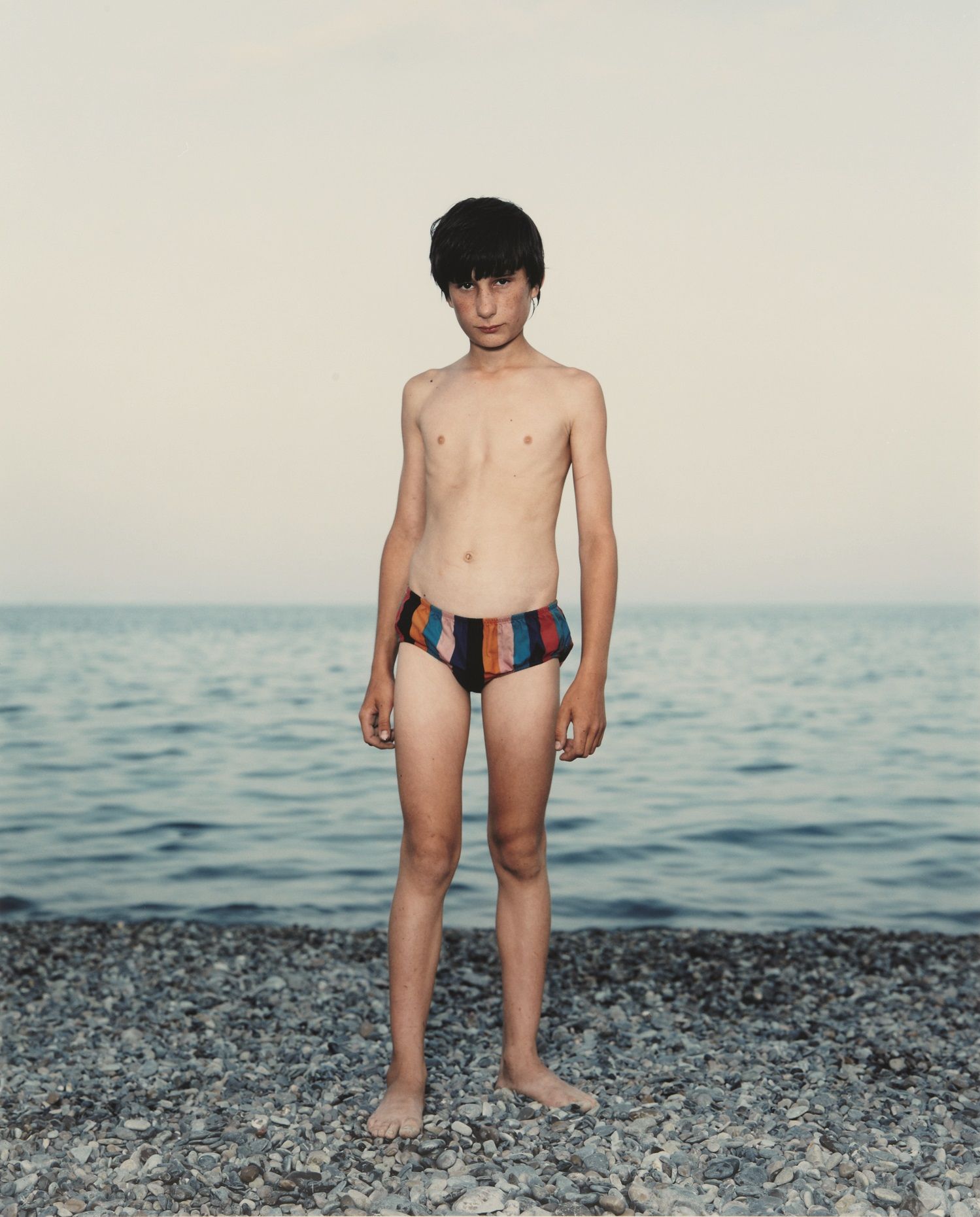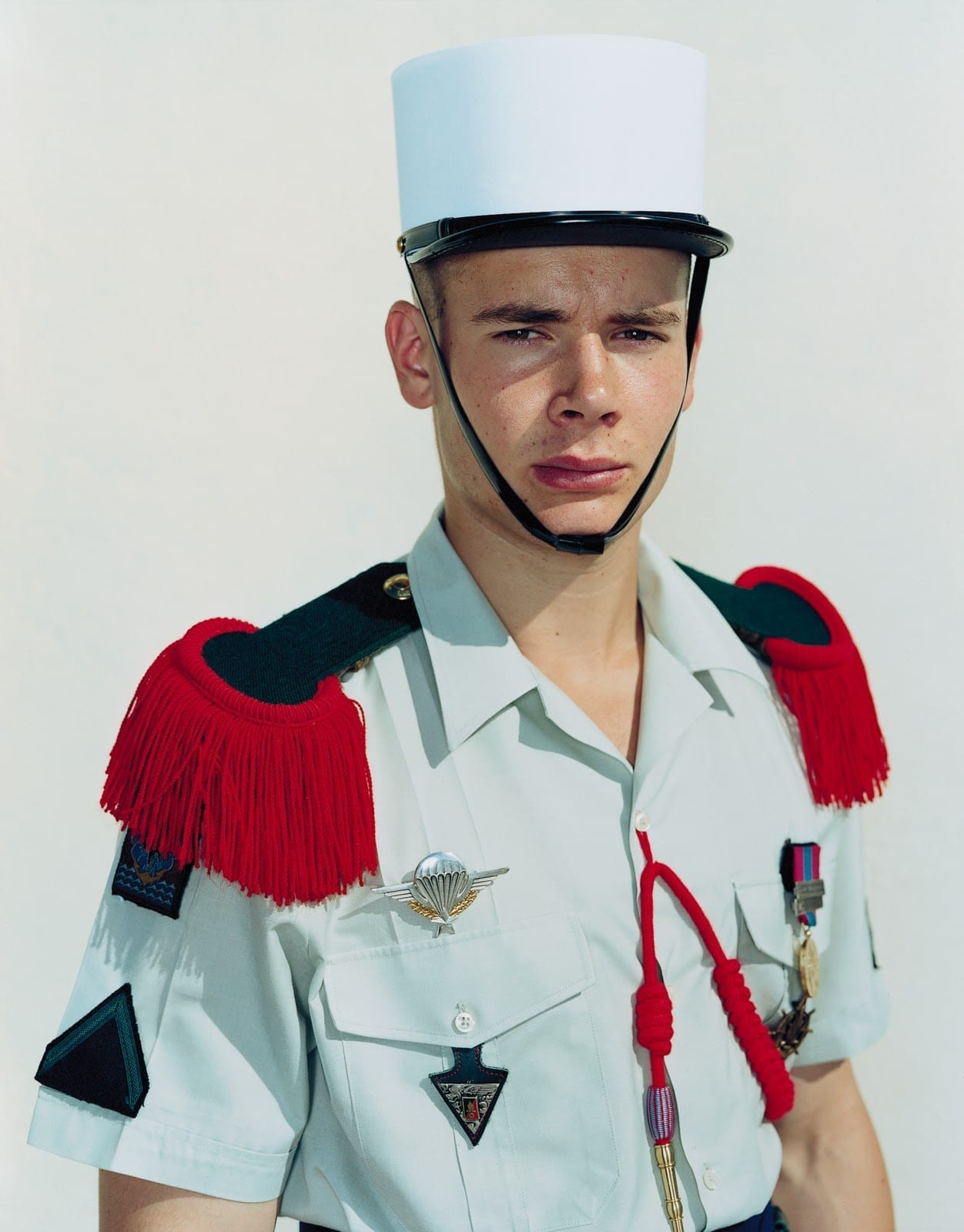One of the things that Rineke Dijkstra does when she makes her photographs is eliminate contextual detail or minimize it.
Transcript of Rineke Dijkstra: A Retrospective Solomon R. Guggenheim Museum, New York June 29 –October 8, 2012
Jennifer Blessing, Senior Curator, Photography: Rineke Dijkstra: A Retrospective is a mid‐career survey of this important Dutch photographer’s work and it includes both works. There are 71 photographs in the show and five video installations, which are installed on four floors. The best way to see the show is to start on the second floor and go from there to the seventh floor where you will see the grand finale of the show, The Krazyhouse [2009].
Rineke is primarily known as a portrait photographer. She uses a large‐format camera that produces beautiful, large negatives.
![]()
Rineke Dijkstra: It’s a slow process of working. It demands a lot of concentration from both me and, you know, the subject, and that creates also a kind of intensity, to get really close to the subject. You can see things that you normally wouldn’t notice because everything is so much in focus. And the size, I think for me the size, it is important that you can still relate to the person in the picture.
Blessing: One of the things that Rineke Dijkstra does when she makes her photographs is eliminate contextual detail or minimize it. So in her early works, the Beach Portraits [1992–2002], there are photographs of adolescents at the edge of the sea in locations around the world. In each case the figure is in tight focus, but the background kind of blurs out and it gives you a sense of atmosphere, and it’s beautiful in terms of the color but it creates a kind of backdrop for the figure.

from Beach Portraits (1992–2002)
“Rineke Dijkstra is very interested in transitional states. She has photographed new mothers right after giving birth, after they have experienced an incredibly demanding physical and emotional experience. She also photographed Portuguese bullfighters right after they had come out of the ring, also involved in a demanding kind of experience.”
Dijkstra: It was sort of a studio backdrop. It always appeared in a different way, because, you know, it depends on the weather, it depends on the time of the day. It’s always different colors; it’s never the same. By isolating people, by just taking them out of their context, it was just about [the] figures. When you escape everything from the image, which is not important, you start to focus much more on the details, and those details can tell a story.
Blessing: In subsequent bodies of work, when Rineke shot indoors, she minimized the backgrounds by removing furniture, or in the case of the photographs of New Mothers [1994], Rineke asked them to stand in a place against a white wall, creating almost a studio within their home.
Dijkstra: In Holland most women give birth at home. One of my best friends gave birth to her first child, and I was there and I witnessed that whole process of [going] into labor. So, when the baby was finally there she showed it to me, and I mean, there were so many emotions at that moment, you know, she was proud, she was exhausted, she was happy, she was relieved, and it was such an intense moment that I was just wondering if it was possible to capture all of those different emotions in an image.
![]()
Blessing: Rineke Dijkstra is very interested in transitional states. She has photographed new mothers right after giving birth, after they have experienced an incredibly demanding physical and emotional experience. She also photographed Portuguese bullfighters right after they had come out of the ring, also involved in a demanding kind of experience. This came out of a portrait that she made of herself when she was involved with doing rehab after an accident and she was swimming. She found that when she was exhausted she felt she could take a picture that was un‐posed and captured her exhaustion, but also her emotional state.
Dijkstra: So after working in commission for a couple of years I wanted to work on, maybe, a project, which was more related to myself. And so, I took two months off to think about it, but nothing really came up at [the end of the] two months, and the last day of that period I had a bicycle accident and I broke my hip.
So, I had to stay in bed for five months and after that I had to do exercises for rehabilitation to recover from that accident and I had to swim every day. And I swam every day, thirty laps, and one day I had the idea to take a self‐portrait after swimming. At that point you are too exhausted, you are really tired, so you don’t think about a pose and it arises more unconsciously.
Blessing: Rineke’s videos are very much like her photographs. They capture an individual isolated against a white backdrop. The camera is still and yet, of course, you have the capacity to see a person moving. She is very interested in the way people dance and experience music and the way that we respond to it. In 2009, Rineke Dijkstra shot a video in Liverpool at a club called Krazyhouse.

Dijkstra : In The Krazyhouse I wanted to see if you could make a portrait of somebody that reveals parts of themselves just by dancing. I did the casting and I built a studio also in a club because I thought that was a place where they maybe feel more comfortable.
What I like about building a studio is that I like to create circumstances where things can happen. I am a director at that point, but at the same time I want to leave things open. So it’s sort of a mixture of trying to have control and not having control.
Blessing: The piece is realized as a series of five individual portraits and you see one dancer at a time on each of the four walls of the installation. Each has a quite different personality that comes across, and in each one you see how important the music is for them. And it is especially interesting in the portrait of Dee, for example, where initially she’s hesitant, it seems that it’s not music that she’s quite familiar with, and you experience in real time as she gradually kind of connects with the music. And suddenly there’s a line, “when love takes over,” and she starts to completely engage the music.
Recently, Rineke made a piece called I See a Woman Crying (Weeping Woman) [2009], which is a wonderful three‐channel [HD] video installation that she made at the Tate in Liverpool. She was working with school children who had been visiting the museum and she saw them interacting, responding to artworks in the museum. So, she asked to have a group of the children respond to a painting by [Pablo] Picasso that you never see on camera, but it is a painting called Weeping Woman [1937], so its subject is already an emotional one, and it’s very abstract so there is a lot of room for interpretation. And the children respond to this artwork in a very open and candid and speculative way, and also bring to it their own worries and concerns as they try to understand why the woman in the picture is so upset.
In all of her work you are very conscious, I think, of her empathy for her subjects. Even when they seem somewhat uncomfortable, they also seem very brave. There is a kind of mixture of a lot of emotion in what are really very deadpan, straightforward, realistic photographs.

ASX CHANNEL: RINEKE DIJKSTRA
(All rights reserved. Text @ the Guggenheim Museum and Rineke Dijkstra. Images @ Rineke Dijkstra)
